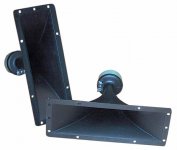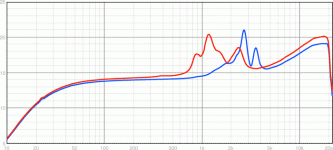lndm said:I feel it ultimately comes down to how far you're prepared to go. Building your own amp and speaker as a pair, can be very rewarding.
And ultimately it is the only way to get the best hifi -- and even more so when you are working within a budget.
dave
The technical discussion has been over my head, and for somebody who has been struggling with speaker selection caused by fallng in love with SET amps, this is a very informative topic.
I bought an 89dB Infinity Kappa 200 bookshelf which I used with my Fase Evoluzione integrated amp (75W, SS) that ultimately was driven by a 2A3 amp a quite sometime. I can't believe it myself how a 2A3 amp can drive this speaker and can reasonably play loud music without distortion.
About a dozen more speakers, I have auditioned with my gears, from single drivers to the expensive Coincident Triumph Signatures but I found "glory" in this-
I have no idea what I'm doing at all, as there's no science in it, Frankenstein was even better. My basis was just to cover the frequency range and use an Altec 406-8Y woofer, Oxford horns which I have no idea about other than it rolls off at10kHz and FT-35H Fostex tweeter. It has a simple first order xover.
I don't know the efficiency, but my less-than-a-watt 10Y amp can drive these to really loud volumes.
So my question is, what have I brewed here? Should I just listen to the music and forget about the technicalities?
ps.
The cabinet is based on the Altec 614 cabinet plans.
I bought an 89dB Infinity Kappa 200 bookshelf which I used with my Fase Evoluzione integrated amp (75W, SS) that ultimately was driven by a 2A3 amp a quite sometime. I can't believe it myself how a 2A3 amp can drive this speaker and can reasonably play loud music without distortion.
About a dozen more speakers, I have auditioned with my gears, from single drivers to the expensive Coincident Triumph Signatures but I found "glory" in this-
An externally hosted image should be here but it was not working when we last tested it.
I have no idea what I'm doing at all, as there's no science in it, Frankenstein was even better. My basis was just to cover the frequency range and use an Altec 406-8Y woofer, Oxford horns which I have no idea about other than it rolls off at10kHz and FT-35H Fostex tweeter. It has a simple first order xover.
I don't know the efficiency, but my less-than-a-watt 10Y amp can drive these to really loud volumes.
So my question is, what have I brewed here? Should I just listen to the music and forget about the technicalities?
ps.
The cabinet is based on the Altec 614 cabinet plans.
My friend used measurement microphone and square pulses to experiment with his speakers and found that 6 db/oct crossover for a tweeter with a woofer without any crossover is the best way to reproduce a music. You may not see the whole picture while measure frequency response using steady sinusoidal tones, but pulses show well what happens on sharp phase shifts. However, he is an orthodox engineer and uses SS amplifier thinking that I am an audiofool. However, a guy in a local Hi-Fi store thinks that I am insane because I am an engineer and spits on me when I ask questions. 
arnoldc said:Oxford horns which I have no idea about other than it rolls off at10kHz
Based on a Jensen design, and built by many OEMs including jensen, Oxford, & Foster...
dave
Hi wavebourne, I wish I have the equipment or have a friend with equipment to measure the in room characteristic of my speakers.
Hi dave, I was told it's an Oxford mid-horn. Maybe you know the equivalent?
ps.
And what was my fingers thinking when I typed FT-35H It's a Fostex FT-17H tweeter
It's a Fostex FT-17H tweeter 
pps.
So what made this speaker tube friendly?
Hi dave, I was told it's an Oxford mid-horn. Maybe you know the equivalent?
ps.
And what was my fingers thinking when I typed FT-35H
 It's a Fostex FT-17H tweeter
It's a Fostex FT-17H tweeter pps.
So what made this speaker tube friendly?
Impedance compensation will help an active system as much as a passive one. The active does have advantages, of course.planet10 said:And ultimately it is the only way to get the best hifi
arnoldc said:I was told it's an Oxford mid-horn.
Looks like the attached? If it is an Oxford it should have the number 465 on it (grouped with 3 or 4 trailing numerals)
dave
Attachments
I like using copper foil inductors in the cross over network along with high quality capacitors. I can't remember if I got the copper foil inductors at Parts Express or not.
http://www.partsexpress.com/webpage.cfm?WebPage_ID=316
These horn speakers work pretty good. I get good base reproduction using 6550 tubes in my Heathkit monoblock amps. The wiring and biasing had to be modified to use them in the amps.
http://www.flickr.com/photos/98366157@N00/sets/72057594070316810/
http://www.partsexpress.com/webpage.cfm?WebPage_ID=316
These horn speakers work pretty good. I get good base reproduction using 6550 tubes in my Heathkit monoblock amps. The wiring and biasing had to be modified to use them in the amps.
http://www.flickr.com/photos/98366157@N00/sets/72057594070316810/
tube-friendly loudspeaker
Dear all,
What makes a loudspeaker tube-friendly ?, the answer is simple but clouded in a myriad of very valid, but less significant, parameters and issues. To name a few: Damping-factor, Efficiency, Back-EMF, Flatness impedance curve, Impedance phase angle, andsoforth, andsoforth.
I have constructed two loudspeakers with the Jordan JX92S, and at this moment in time I am constructing a third loudspeaker. All three loudspeakers have a different design concept. Next to this, I have surfed the Internet for days. Based on all this funwork, I have the following simple answer:
A tube-friendly loudspeaker should not draw large currents, or quick changes in current, from the tube-amplifier. This means that the air in the cabinet should not load the driver. The driver is loaded by means of resonance.
Massive resonance should be avoided ... so in principle phase-twisting cabinets should be avoided, such as:
1) Bass reflex cabinets. If you must use it, try to keep the volume of the cabinet (litres) close to the mass of the driver-cone (grams). To much Q (more than 0.707) might be compensated with stuffing/wadding;
2) Mass-Loaded Tapered Quarter Wave Tubes;
3) Transmission Lines. See bottom-NOTE.
Next to this, it seems wise to make sure that the Impedance is always (20 Hz - 20 kHz) higher than the nominal value of the tapping that you select on the tube-amplifier (4, 8 or 16 Ohms).
Some resonancy is desired in order to extend bass performance.
You're welcome to visit my website: fatpipetranny.com
Bottom-NOTE.
IMO there a two families of Transmission Lines:
1) TL's designed to provide bass boost for small drivers with low linear excursion (Martin King, Robert Brines). Striking property: a very wavy Impedance curve;
2) TL's designed to kill the backwave of big woofers (Dr. Bailey). Striking property: a very flat Impedance curve.
I may be that the last family is tube-friendly inspite of strong loading, something to try in the future.
Dear all,
What makes a loudspeaker tube-friendly ?, the answer is simple but clouded in a myriad of very valid, but less significant, parameters and issues. To name a few: Damping-factor, Efficiency, Back-EMF, Flatness impedance curve, Impedance phase angle, andsoforth, andsoforth.
I have constructed two loudspeakers with the Jordan JX92S, and at this moment in time I am constructing a third loudspeaker. All three loudspeakers have a different design concept. Next to this, I have surfed the Internet for days. Based on all this funwork, I have the following simple answer:
A tube-friendly loudspeaker should not draw large currents, or quick changes in current, from the tube-amplifier. This means that the air in the cabinet should not load the driver. The driver is loaded by means of resonance.
Massive resonance should be avoided ... so in principle phase-twisting cabinets should be avoided, such as:
1) Bass reflex cabinets. If you must use it, try to keep the volume of the cabinet (litres) close to the mass of the driver-cone (grams). To much Q (more than 0.707) might be compensated with stuffing/wadding;
2) Mass-Loaded Tapered Quarter Wave Tubes;
3) Transmission Lines. See bottom-NOTE.
Next to this, it seems wise to make sure that the Impedance is always (20 Hz - 20 kHz) higher than the nominal value of the tapping that you select on the tube-amplifier (4, 8 or 16 Ohms).
Some resonancy is desired in order to extend bass performance.
You're welcome to visit my website: fatpipetranny.com
Bottom-NOTE.
IMO there a two families of Transmission Lines:
1) TL's designed to provide bass boost for small drivers with low linear excursion (Martin King, Robert Brines). Striking property: a very wavy Impedance curve;
2) TL's designed to kill the backwave of big woofers (Dr. Bailey). Striking property: a very flat Impedance curve.
I may be that the last family is tube-friendly inspite of strong loading, something to try in the future.
- Status
- This old topic is closed. If you want to reopen this topic, contact a moderator using the "Report Post" button.
- Home
- Amplifiers
- Tubes / Valves
- What makes a speaker "tube-friendly"?

